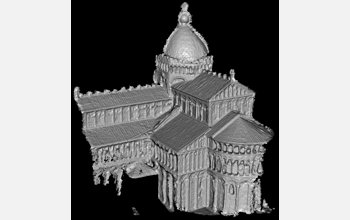Multimedia Gallery
3D Model of Duomo, Pisa
Three-Dimensional Model of Duomo, Pisa
A rendering of a 3D model of the Duomo in Pisa, reconstructed from 56 photographs (captured by eight photographers) downloaded from the Internet photo-sharing site Flickr. Images found on these public photo-sharing sites can now be used to help build accurate 3D models of the real world.
More about this Image
With the rise in popularity of Internet photo-sharing sites like Flickr and Google, community photo collections (CPCs) have emerged as a powerful new type of image dataset. These photo-sharing sites have captured most of the world's significant landmarks from a huge number of vantage points and viewing conditions. For example, a Google image search for "notre dame" or "grand canyon" each returns more than half a million photos, showing the sites from myriad viewpoints, different times of day and night, and changes in season, weather and decade. This kind of data presents an opportunity to reconstruct the world s geometry using the largest known, most diverse and largely untapped, multi-view stereo dataset ever assembled. What makes the dataset unusual is not only its size, but the fact that it has been captured "in the wild," not in the laboratory, leading to a set of fundamental new challenges in multi-view stereo research.
Now, a team of researchers from the University of Washington have developed a method using software that recreates real structures in 3D by analyzing hundreds of different public images.
First, the software selects images suitable for stereo comparison from public sites. After performing a search to collect the images, it discards those that are too dissimilar. Next, the software uses a combination of different computer vision techniques to create a 3D model of the scene. A process called "structure from motion" identifies 3D points across the surface of a building using images taken from different angles. The rest of the surface is then built on top of these points using the collected images. The approach was found to be very accurate when taking into account variations in lighting and perspective--often as accurate as existing 3D reconstruction methods. To see other examples of 3D reconstruction, or for more information, visit the Multi-View Stereo for Community Photo Collections project page. This research was supported in part by National Science Foundation grants IIS 04-13198 and EIA 03-21235. (Date of Image: 2007)
Credit: Michael Goesele, TU Darmstadt and collaborators at the University of Washington
Images and other media in the National Science Foundation Multimedia Gallery are available for use in print and electronic material by NSF employees, members of the media, university staff, teachers and the general public. All media in the gallery are intended for personal, educational and nonprofit/non-commercial use only.
Images credited to the National Science Foundation, a federal agency, are in the public domain. The images were created by employees of the United States Government as part of their official duties or prepared by contractors as "works for hire" for NSF. You may freely use NSF-credited images and, at your discretion, credit NSF with a "Courtesy: National Science Foundation" notation.
Additional information about general usage can be found in Conditions.
Also Available:
Download the high-resolution JPG version of the image. (157 KB)
Use your mouse to right-click (Mac users may need to Ctrl-click) the link above and choose the option that will save the file or target to your computer.

